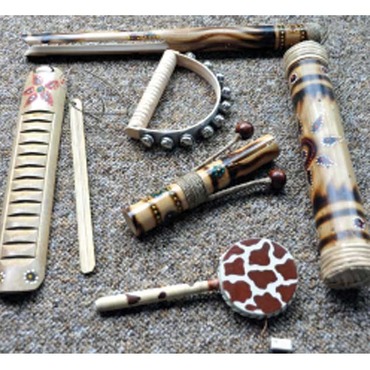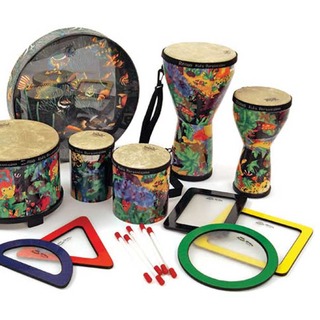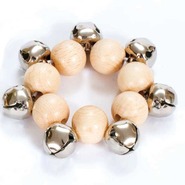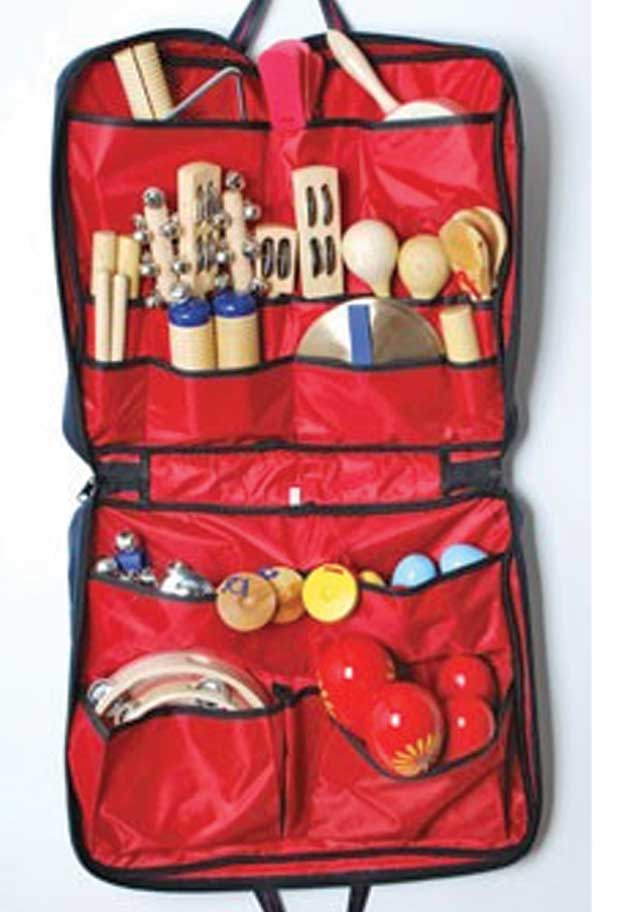
Pattern surrounds us, and the human mind actively seeks it out to help us make sense of the world. Pattern is central to mathematics, nature and our understanding of time; it is evident in our behaviour and the built environment (see more information column). And it is central to movement and language.
Children pick up on the rhythmic patterns of their mother's speech when they are in the womb. Practitioners can foster children's interest in sound and movement patterns long before the child is old enough to communicate verbally by highlighting patterns in stories, in music and verse and through the rhythms of speech during conversations.
Hearing and sound are vital in a child's development. The ear of the foetus is fully formed by five months, allowing him to hear the sound of the mother's voice. Children are innately musical and, as Charles Darwin said, our ancestors probably sang before they spoke. This is true for babies today.
Marjorie Ouvry, consultant in early years education with a specialism in music and outdoor play, says, 'Music trains the ear to pattern. Music and movement are the precursors to language, and language is the precursor to literacy and numeracy. Therefore, it is essential that children have an understanding of the patterning in sound and gesture, and in music and movement, before they are taught to read formally.'

MUSIC
Practitioners should start by listening out for the patterns that young children make when holding a rattle or a shaker. Ms Ouvry says, 'By recognising and respecting the sounds that they are making, we can extend their music-making.
'Pattern-making in music is when elements of the music are rhythmically repeated in different ways — fast and slow, high and low, harsh and soft, and rhythmic and pulse. Understanding these structural devices, which make up the composition of music, will help the practitioner to understand children's attempts to make patterns in music.'
For example, a child may have a shaker in his hand, making what appears to be random sounds. But on careful listening, elements of the music may be recognised, such as 'loud, loud, loud', 'fast, fast, fast' and 'slow, slow, slow'.
Practitioners could copy these sounds with a shaker, as it will validate the child's explorations. With older children, it is useful to look out for their sound patterns while they are playing at the sand pit or in the home corner.
Ms Ouvry explains, 'Older children will sing at the drop of a hat. They love to make up their own songs. They love patterning through songs and rhymes and they respond in joy when the patterns change and then resolve. Rhymes like Polly Put the Kettle On and The Grand Old Duke of York are wonderful practice for phonics and patterning.
'But practitioners can encourage them further by understanding the structure of lullabies and nursery rhymes and making up their own words to these rhymes based on the children's names or the situations they are in. The patterns then become more memorable.'
Musical instruments
Here are some musical instruments to include in your collection.

- Sets of claves and beaters are great for group music pattern-making activities. They are also great to explore beats and patterns in sounds for Phase 1 phonics work. Try the Music Set for Phase 1 Phonics (£23) from Cosy Direct, on 01332 370152, or the Slim Rosewood Claves (£4.45) from www.mesdirect.com.
- Popular sets of bells include the Indian Bells (£3.75) - two solid brass cymbals that give a rich high-pitched tone - the Chinese Bells (£5.75), the Natural Wooden Wrist Bells (£4.45), all available from www.mesdirect.com. A large Setting Percussion Bag (£139.99) is available from www.reflectionsonlearning.co.uk.
- For group music sessions, try the Egg Shakers Class Pack, of 30 shakers, from www.mesdirect.com (£34.95). Or try the pack of four metallic Rhythm Eggs (£6.29) from www.earlyyears.co.uk.

- Drums are available in all shapes and sizes and they make wonderful sounds for children to explore. Try the range of drums from www.mesdirect.com, which includes the Remo Classroom Set of six sound shapes, an ocean drum, a bongo, a djembe and a gathering drum (£285) or the hand-made Small Gato Drum and Beaters (£52.95).
MOVEMENT
When listening to music, it is almost impossible for young children to be still. Many group music sessions take place with practitioners sitting in a circle with small groups of children while they sing songs and clap or use musical instruments. But Ms Ouvry would like to see music and movement sessions taking place outdoors, where the children are free to move on a larger scale.
She says, 'Take a tambourine and a small group of children outdoors. Do a rhythm on a tambourine — "bang bang, bangbang, bang bang, bangbang" — and encourage the children to move to the music. They might want to jump into the air and contact the ground on each beat. Then ask the children if they would like to do a pattern while the practitioner moves to the beat — crawling, spinning and skipping — and using all the elements of bodily movement.'
Movement props
Here are some examples of props to use when moving to music. 
- Explore patterns in movement through dance using the set of 10 Dancing Scarves (£4.99) or the Make Your Own Dance Rings set (£9.99) from Cosy Direct. Also available are Holding Streamers (£16.99) and Glittery Dance Scarves (£15.99) from www.tts-group.co.uk, and six Dancing Ribbons (£12.99) from www.reflectionsonlearning.co.uk. A Dance Movement Pack (£107.05) is available from www.hope-education.co.uk.
- Jabadao suggests creating a movement area — a large open space with some soft surface as well as a slidable surface. Provision should include props to support movement such as scarves and hoops and props to support tactile experience — such as brushes, and fabrics with different textures. For more information visit www.jabadao.org.
- Create obstacle courses with patterned movement using tunnels, crates or tyre tracks. Try the set of 32 Tyre Tracks (£120), The Barefoot Island Trim Trail with 9 pieces of wood (£37.99) or the H Crates Class Pack (£49.20), which are ideal for seating, building and walking on, all from Cosy Direct.
LANGUAGE
When reading favourite books and traditional tales with children, practitioners can highlight patterns both in the language and structure of the story.
Not only can this encourage children to predict what might happen next, but it can also remind them of the patterns of behaviour. Practitioners can also share the enjoyment of repeated words or phrases such as 'huffed and puffed' or repeated syllables in rhyming texts.
Stories
Pattern features in many picture books - just think of We're Going on a Bear Hunt by Michael Rosen, with its repetitive text that speeds up then tapers down, and the rhyming text of Julia Donaldson.
The 'Oliver' series by Mara Bergman and Nick Maland also has wonderful rhyming text, as do many Claire Freedman stories — see, for example, The Great Snortle Hunt.
Rich in pattern in every sense is The Big Snuggle-up by Brian Patten and Nicola Bayley and for a change of pace there's always Peter Bently and Jim Field's Farmer Clegg's Night Out — featuring a break-dancing horse.
There is an enormous range of rhyme books available for this area of practice, but for a fresh take on traditional rhymes check out Alison Murray's One Two That's My Shoe!, Hickory Dickory Dog and The House That Zac Built. Visit www.nurseryworld.co.uk/equipment for book reviews.
CASE STUDY: ALFRETON NURSERY SCHOOL
Children at Alfreton Nursery School in Derbyshire can't wait for Roly Poly Fridays each week, where a small group listen to nursery rhymes and move their bodies accordingly. Nursery nurse Jane Blant says, 'These sessions are not only aimed at promoting the use of core muscles, which helps with brain development, but they are also an early introduction into physical moving patterns.
'We cover three key movements - rolling, balancing and crawling - using traditional nursery rhymes to encourage them, in a fun way, to do the actions. For example, if we are looking at balance we will sing I'm a Little Teapot; for rolling, the children lie on the mat and we sing and do the actions to There Were Three in the Bed. It's a 15-minute session, which is simple yet effective. The staff are excellent at improvising and changing the words to songs and rhymes, which makes the session so much fun - and the children are unaware how much they are learning.'









